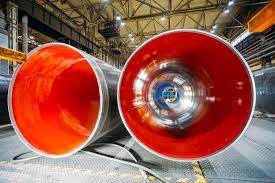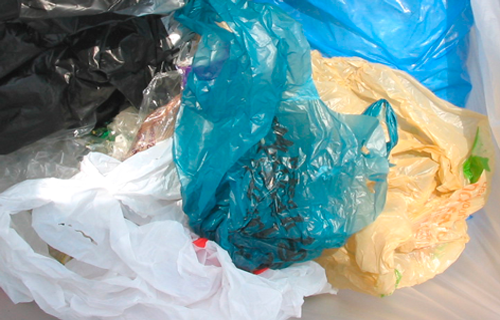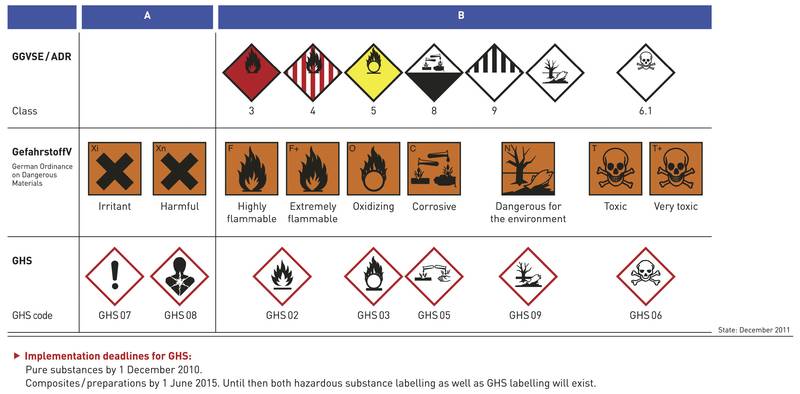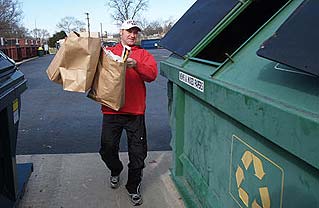European steelmakers warn they have reached the limits of how much recycled metal can feed their mills as competition for scrap is driving
exports to emerging Asian economies. EurActiv reports from ArcelorMittal’s factory in Ghent, Belgium.
Environmental concerns were hardly an issue when Luxembourg steel giant Arbed founded the Ghent production site in 1959.
Today, the factory’s owners have changed and the priorities have shifted to international competition and resource efficiency, with recycling taking a more prominent role.
Between 10 and 15% of the steel rolls that come out of ArcelorMittal’s Ghent factory are made from recycled metal. Using scrap reduces the need to import iron ore, whose prices have sky-rocketed in recent years. It also helps save energy as the metal can be melted directly in the steel mill.
“We us a lot of scrap,” says Richard Mortier, head of environment at ArcelorMittal’s Ghent factory. However, he says scrap use in the factory, which mainly produces high-quality flat steel for the automotive sector, is now reaching its limits, with up to 200 kg that can effectively be used for every tonne produced.
“That is really the maximum feasible,” Mortier says, explaining that going beyond this would require an additional – and expensive – separate facility to melt down the scrap.
Scrap metal becoming scarce
What’s more, not all products containing metal are suitable for recycling.
Old cars for example contain lots of “exotic materials” like copper, plastics or batteries which could alter the quality of the steel demanded by automotive clients, Mortier says. And other products such as beverage cans would not fit either “because we cannot guarantee the quality” of the end product.
But even for lower quality metals, increasing recycling rates has become difficult because there is simply not enough scrap available on the market.
“While demand for scrap is rising rapidly worldwide, generation of scrap has been lagging,” says Matteo Rigamonti of the European steelmakers association Eurofer.
Europe generates enough scrap for its own needs but most of it is being shipped abroad, to emerging Asian economies, Rigamonti says. “Only a mature economy such as the EU generates sufficient volume of (old) scrap to meet demand, in contrast with emerging or developing countries which do not yet have the industrial infrastructure dating back over many years to generate scrap volumes.”
Over the last decade, exports of scrap metal from the EU-27 have doubled, from 9,403 tonnes in 2000 to 18,985 tonnes in 2010, according to Eurostat figures. Meanwhile, the consumption of recycled scrap has tended to decrease, from 100,256 tonnes in 2000 to 95,900 in 2010, according to Eurofer.
“In recent years we have seen an alarming increase in scrap exported from the EU to third countries,” Rigamonti told EurActiv.
Rigamonti says this is due mainly to distorted competition on the international scrap market. “While the European market is completely open with no restrictions whatsoever on scrap exports, a huge number of countries restrict their exports of domestic scrap,” he complains.
Differing qualities of scrap
Another explanation for the declining recycling figure is that lower quality scrap is increasingly being shipped abroad for melting at a cheaper price than in Europe.
“Production capacity in the Middle East and Far East has been growing quite significantly in the past few years and further expansions are under construction,” Rigamonti says, citing Turkey but also Iran, Saudi Arabia and the UAE.
These lower quality steels are produced using a method called Electric Arc Furnace (EAF), used for example to produce metal beams for the construction industry or to build railway tracks.
“In electric arc furnace [production], the percentage of scrap you can use goes up to 100%,” Mortier explains, whereas the ArcelorMittal Ghent factory mainly produces flat steel based on pure iron ore.
“What we are producing here is flat steel products with high added value, high strength steels. And there you have metallurgical constraints, you can’t foul your pure steel with residuals which are in scrap, inevitably,” Mortier says. “We have to be very careful in the scrap we purchase.”
Besides, part of the steel never finds its way back to the production chain. Old cars may be exported outside Europe and metal beams used in construction might stay in the ground after buildings are demolished, meaning some steel is lost indefinitely.
“If you look at global steel markets, there is much more steel demand than what you can produce out of scrap. So you need a source of fresh steel,” says Mortier. “The issue is scrap availability,” adds Koen Coppenholle from ArcelorMittal. “There is not enough scrap to produce your steel,” even for lower quality products, he says.
Future plans
In the future, the Ghent factory is considering raising its capacity for melting recycled steel. “We have some investment programmes which we have prepared to increase scrap use in the steel mill,” says Mortier.
This, he says, will require investments in a new facility to melt the scrap metal. “In fact, what we need is a new little steel mill where we could have an electric arc furnace dedicated for our own production,” said Mortier, roughly evaluating the investment at around one hundred million euros “at least”.
Source : www.euractiv.com







